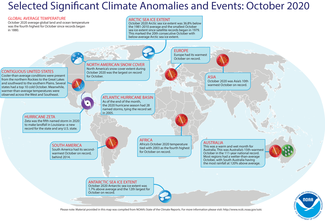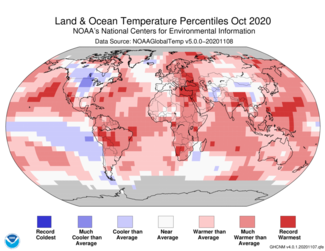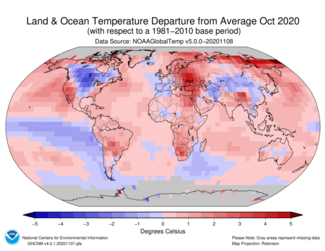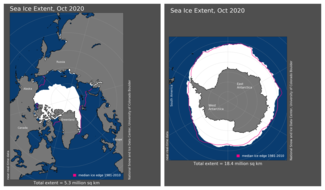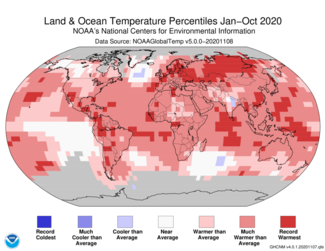
The October 2020 globally averaged temperature departure from average over land and ocean surfaces was the fourth highest for the month of October in the 141-year NOAA global temperature dataset record, which dates back to 1880.
This monthly summary, developed by scientists at NOAA National Centers for Environmental Information, is part of the suite of climate services NOAA provides to government, business, academia and the public to support informed decision-making.
October 2020
The October 2020 global land and ocean surface temperature was the fourth highest for October in the 141-year record at 1.53°F (0.85°C) above the 20th-century average of 57.1°F (14.0°C). The ten warmest Octobers have occurred since 2005, while the seven highest October temperature departures from average have occurred in the last seven years (2014-2020).
- October 2020 marked the 44th consecutive October and the 430th consecutive month with temperatures, at least nominally, above the 20th-century average.
- The Northern Hemisphere land and ocean surface October 2020 temperature was also the fourth highest on record, while the Southern Hemisphere had its ninth-warmest October in the 141-year record.
- Europe had its warmest October on record, with a temperature departure of +3.91°F (+2.17°C). This surpassed the previous record set in 2001 by 0.11°F (0.06°C). South America had its second-warmest October since regional records began in 1910. Africa, Asia, and the Caribbean and Hawaiian regions' October 2020 temperature departures ranked among the 10 highest for October on record. Meanwhile, North America had a near-average October temperature.
- During the month, warmer-than-average temperatures were observed across a large portion of the world, with record warm October temperatures across parts of the northern and western Pacific Ocean, southern North America, South America, eastern Europe, the northern Middle East, eastern Mediterranean Sea, southern Asia and in small areas across the Indian and Atlantic oceans. Cooler-than-average October temperatures were observed across much of Canada, the central contiguous U.S., western Eruope, and across parts of southern Asia, the central and eastern tropical Pacific Ocean, and the southwestern Indian Ocean. However, no land or ocean areas had record cold October temperatures.
Snow and Sea Ice
According to data from NOAA and analysis by the Rutgers Global Snow Lab, the Northern Hemisphere snow cover extent during October was 1.42 million square miles above the 1981-2010 average and the 10th-largest October snow cover extent in the 53-year period of record. The North American snow cover extent was largest on record for October, while Eurasia had its 19th-largest October snow cover extent on record.
The October average Arctic sea ice extent was the smallest for October on record at 1.19 million square miles (36.8 percent) below the 1981-2010 average, according to analysis by the National Snow and Ice Data Center (NSIDC) using data from NOAA and NASA. This surpassed the previous low record that was set only last year (2019) by 173,700 square miles. October 2020 marked the 20th consecutive October with below-average Arctic sea ice extent. According to the NSIDC, below-average sea ice extent was observed in all of the sectors of the Eurasian side of the Arctic Ocean and in the Baffin Bay.
Antarctic sea ice extent during October 2020 was 120,000 square miles above average. This was the largest October Antarctic sea ice extent since 2015 and the 12th-largest October Antarctic sea ice extent in the 42-year satellite record.
January-October 2020
The year-to-date global land and ocean surface temperature was the second highest in the 141-year record at 1.80°F (1.00°C) above the 20th-century average of 57.4°F (14.1°C). This value is only 0.05°F (0.03°C) shy of tying the record set in 2016.
- The Northern Hemisphere January-October land and ocean surface temperature was the warmest such period since global records began in 1880 at 2.32°F (1.29°C) above average. This was 0.04°F (0.02°C) higher than the now second-warmest such period set in 2016. The Southern Hemisphere had its fourth-warmest such period on record.
- Europe and Asia had their warmest January-October period on record. South America and the Caribbean region had their second warmest January-October period, while Africa and Oceania had their fifth- and sixth-highest such period on record, respectively.
- The first 10 months of the year were warmer than average across much of the globe. Record warm January-October temperature departures were widespread across northern and southeastern Asia and across parts of Central and South America, Europe, the Indian, Atlantic and the western and northern Pacific oceans. Meanwhile, cooler-than-average conditions were limited to Alaska, western Canada, northern India and across the eastern tropical Pacific Ocean, the North Atlantic Ocean and the southern oceans.
- According to a statistical analysis done by NCEI scientists, the year 2020 is very likely to rank among the three warmest years on record.
For a more complete summary of climate conditions and events, see our October 2020 Global Climate Report.

